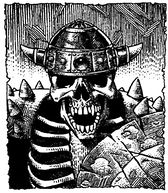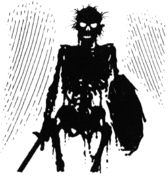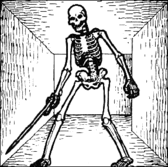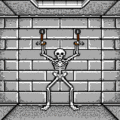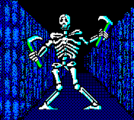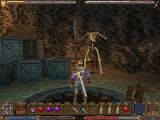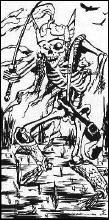Skeletons
| Skeletons | |
|---|---|
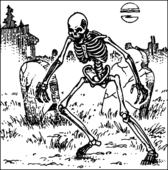 Skeleton, from Ultima IV manual | |
| First appearance: | Ultima I |
| Last appearance: | Ultima IX |
Animate skeletons have long plagued many worlds, including Sosaria, Britannia, the Serpent Isle and Pagan. Of the undead, skeletons typically rank amongst the weaker specimens, although these creatures have been known to overwhelm the living through strength of sheer numbers. Skeletons feature in Ultima I, Ultima III, Ultima IV, Ultima V, Ultima VI, Ultima VII, Ultima VII Part Two, Ultima VIII and Ultima IX, as well as in Ultima Underworld and Ultima Underworld II.
Description[edit]
These creatures generally have their origins with necromancers, liches or other practitioners of dark magics (and are often seen in their company), although it is rumored that in places of great evil, the bones of the dead may rise of their own accord, or may spring full formed from unliving stone. Typically taken from the stock of fallen warriors, skeletons prove relentless combatants, fighting with near to the same proficiency as they had while still alive. These beings seemingly suffer from neither pain nor exhaustion, and in almost all cases have no mind save the will of whomever reanimated them. If they are outfitted, it is often with whatever rusted weapons and decaying armour they died in, although axes seems particularly common equipment for the skeletons in service to Pagan's Lithos.
In the late Age of Darkness, clerics created a means of dispelling the magic which created such undead (along with their close relatives: ghouls and zombies) leaving them naught but immobile piles of bone. While this incantation (known as Pontori),[1] appeared to later reemerge as the Britannian spell An Corp Mani,[2] such magic eventually fell into disuse, and by the time of Lord Blackthorn's regime in the middle Age of Enlightenment, the means of dismantling skeletons through such means had become a lost art.
Enchanted skeletons can remain inert for long spans of time, and may make the sudden transformation from what appears to be a harmless pile of bones into a hostile fighter near instantaneously. In later ages, such skeletons could even re-arise after having been dispatched, making it often necessary for those battling them to separate their bones to prevent them from reforming.
In some rare cases, a skeleton has been found which retains the consciousness of its original owner, and such undead are capable of speech and reason, much like many ghosts. While sentience among skeletons is not always a guarantee of a peaceful temperament, the individuals often seek much the same things as the other restless dead – closure on their former lives which might enable them to at last seek out the Void.
Lore[edit]
| “ | The progeny of Necromancers and undead Liches, Skeletons are the animated corpses of undead warriors from which the flesh hath withered and fallen away. They fight tirelessly in an effort to carry out the bidding of their dark masters. – from The First Age of Darkness (Ultima I)
|
|---|
| “ | All Undead creatures are an abomination before the light of Truth. A Cleric with thy party can Turn these undead creatures. – from The Book of Play (Ultima III: Exodus)
|
|---|
| “ | Animated bones, the Skeletons are the undead incarnations of a variety of creatures. These tools of evil strike fear into ordinary travellers. With the proper enchantment, however, they can be Dispelled. |
|---|
| “ | Perhaps the most common of undead creatures, skeletons lack strength and brains, but they are dextrous and can take a surprising amount of punishment. They often carry some goods. |
|---|
| “ | Skeletons aren't very smart, but they can use weapons. |
|---|
| “ | The expressionless, hollowed eyes of the skeleton belie the malice that animates the otherwise lifeless latticework of bone and sinew. Conjured up by malcontented mages bent on mischief, these creatures — the restless remains of fallen warriors — are both fearless and tireless in battle. – from Compendium (Ultima VI: The False Prophet)
|
|---|
| “ | Perhaps a consequence of the unique, arcane nature of our Abyssal environment, these Undead creatures may be found almost anywhere — some think Skeletons crawl directly out of the rock walls of the chasm! Furthermore, these monsters are most commonly found in groups (should you find on Skeleton, there are likely to be more around the corner). Skeletons hate all living beings. Fortunately, they are weak, ineffective warriors. |
|---|
| “ | This is the undead reanimation of a fighter who was slain on the field of battle. Skeletons tend to cluster in hordes and are often following the commands of a sorcerer. In fact, they may continue to do so well after the sorcerer himself is dead! |
|---|
| “ | No one knows what makes a human skeleton rise and walk on its own, intent on destroying the living. Some claim to have mastered the art of animating and controlling skeletons, but I have yet to see proof of this. Others theorize that skeletons are not human bones at all, but emerge from the rock itself in human form. |
|---|
| “ | The undead remains of warriors from ages past, skeletons fight just as well as their living, fleshy counterparts. Until animated, one skeleton appears no different from another, so the wise traveller will always beware when encountering a disinterred pile of bones. |
|---|
| “ | The remains of warriors from ages past, skeletons are the servants of Lithos and the Necromancers who follow him. Their body and spirits, passed to the Mountain King during interment, are held in waiting until needed. However, they still carry with them the accouterments of their fighting days: axes, swords, shields, armor and so forth. Though dead, these animated skeletons are extremely agile and strong, often felling a man before he can even strike. They are brainless, yet seem to retain much of the fighting skill they possessed in life. Skeletons attack only with their ancient weapons, which are oft times filthy with disease-ridden decay. As they are already dead and serve only a single function, skeleton warriors attack relentlessly until destroyed. – from The Chronicle of Pagan (Ultima VIII: Pagan)
|
|---|
| “ | There is an axiom of adventuring: it is better to burn the bones of a dead friend than to allow them to return as an undead foe. In a place of evil magic, the ambient malice may reanimate the bones of a friend into the form of a skeletal enemy. The animated bones possess all of the combat skills of their former selves yet none of the Virtue. The exist to serve the simple demands of their masters. Blunt weapons are the best correctives. – from Journal (Ultima IX: Ascension)
|
|---|
Notable Examples[edit]
- Banter and Demitry: two of many sentient skeletons found in the ruins of Magincia during Ultima IV; these former men of pride both had knowledge of the Silver Horn necessary to reach the Shrine of Humility
- Skullface: the last of the great Meridid family; lost his life in the fall of Magincia and remained as a skeleton, unaware of his death or of his family's decline into obscurity
- Skitle: a skeleton found in Trinsic during Ultima IV, who had left dungeon Shame and knew about the Purple Stone
- Ferryman: a skeleton in charge of ferrying people in and out of Skara Brae in Ultima VII.
- Lothar: found in dungeon Covetous in Ultima IX where he was bound in service to the liche Khelereth; begged the Avatar for the release of death, which could only be brought about with the magical Gringolet sword
- Giant Skeleton: also in Ultima IX’s Covetous; the largest skeleton encountered in the Ultima series.
Trivia[edit]
- In Ultima V, inanimate skeletons were used for the first time as simple atmospheric decoration. In certain dungeons, humanoid skeletons could be found shackled to the walls, with eyes that would flicker red occasionally as if animated. These bones would crumble to dust when searched.
- Skeletons in Ultima V strangely leave a pool of blood when destroyed.
- In the SNES-port of Ultima VII, skeletons would attack by continuously throwing their own bones at their intended quarry.
- Skeletons were to be included in the canceled Ultima X. See Planned monsters for Ultima X for further details.
Gallery[edit]
A skeleton from the FM Towns-port of Ultima I.
Ultima X concept art
See Also[edit]
- Ultima I monster data
- Ultima III monster data
- Ultima IV monster data
- Ultima V monster data
- Ultima VI monster data
- Ultima VII monster data
- Ultima Underworld II monster data
- Ultima VII Part Two monster data
- Ultima VIII monster data
- Ultima IX monster data
References[edit]
- ↑ Weigers, Margaret et al. The Ancient Liturgy of Truth (Ultima III: Exodus). Origin Systems, Inc.: 1983. Page 3.
- ↑ Albert, Dave. The Book of Mystic Wisdom (Ultima IV: Quest of the Avatar). Origin Systems, Inc.: 1985. Page 51.
